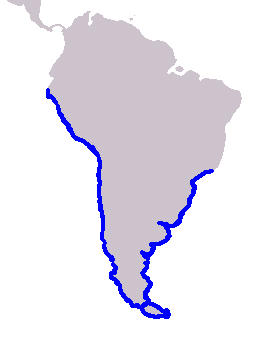Burmeister's porpoise facts for kids
Quick facts for kids Burmeister's porpoise |
|
|---|---|
 |
|
| Size compared to an average human | |
| Conservation status | |
| Scientific classification | |
| Genus: |
Phocoena
|
| Species: |
spinipinnis
|
 |
|
| Burmeister's porpoise range | |
The Burmeister's porpoise (Phocoena spinipinnis) is a type of porpoise that lives only along the coast of South America. It was first studied and named by a scientist called Hermann Burmeister in 1865. In some places, people call it marsopa espinosa, which means 'thorny porpoise'. Another local name is chancho marino, or 'sea pig'.
Contents
Where Burmeister's Porpoises Live
We don't have exact numbers for Burmeister's porpoises. But there are likely tens of thousands of them. They live along the coast from northern Peru in the Pacific Ocean all the way around Tierra del Fuego. Their range extends up to southern Brazil in the Atlantic Ocean.
These porpoises usually stay close to shore. They like bays, channels, and fjords. But some have been seen far out at sea, about 50 km from the coast. They have even been found in the freshwater Valdivia River in southern Chile. While they prefer shallower waters, they can dive very deep, sometimes up to 1,000 meters!
What Burmeister's Porpoises Look Like
Most photos of Burmeister's porpoises show them as black. This is because their skin turns black very quickly after they die. But when they are alive, they are usually a dark grey color. Their underside is often a lighter grey.
Adult Burmeister's porpoises are about 150 cm (5 feet) long. They weigh between 50 and 75 kg (110-165 pounds). The heaviest one ever recorded was a female that weighed 105 kg (231 pounds).
They have a small dip near their blowhole, which is just in front of their eyes. Their dorsal fin is special. Unlike most dolphins or porpoises, it's shaped like a triangle, not curved. It also points more backward than upward. This fin is located very far back on their body. These features help tell them apart from the Chilean dolphin, which lives in the same area.
How Burmeister's Porpoises Behave
Burmeister's porpoises are quite shy. It's hard to get a good look at them in the wild. When they come to the surface for air, they show very little of their body. They also tend to swim away quickly if a boat comes near.
You usually see them alone or in pairs. Sometimes, larger groups are spotted. One time, a group of 70 porpoises was seen in Chile! These porpoises eat different kinds of fish that live in the open ocean. Their diet includes anchovies, hake, and mackerel.
Protecting Burmeister's Porpoises
Like all porpoises, Burmeister's porpoises can get caught by accident in fishing nets. This happens often in Uruguay, Peru, and Chile. In Peru, about 2,000 porpoises are accidentally caught each year. These porpoises are mostly used for food. In the past, people also hunted them on purpose for food and to use as bait for crabs.
Sometimes, big weather events like El Niño can cause problems. During El Niño, the ocean's ecosystem changes. Fish like anchovies might die or leave the area. This means porpoises and other sea animals, including Burmeister's porpoises, might struggle to find food. In 1997, during an El Niño, many Burmeister's porpoises were found stranded on beaches in Peru.
The IUCN lists the Burmeister's porpoise as "Near Threatened." This means they are not in immediate danger, but their future is uncertain.
This porpoise is also listed under Appendix II of the Convention on the Conservation of Migratory Species of Wild Animals (CMS). This listing means that the species would benefit from countries working together to protect it.
See also
 In Spanish: Marsopa negra para niños
In Spanish: Marsopa negra para niños
Images for kids



